Asymmetrical Styling






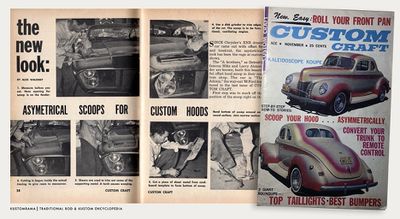
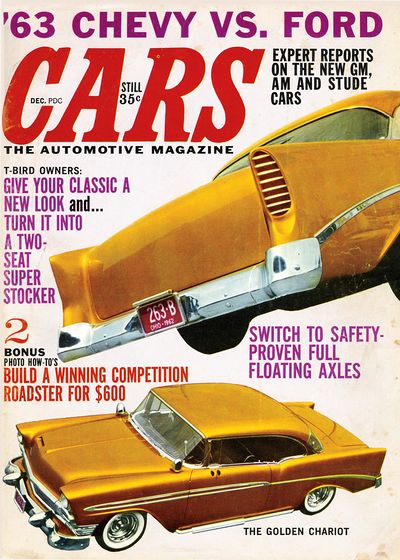
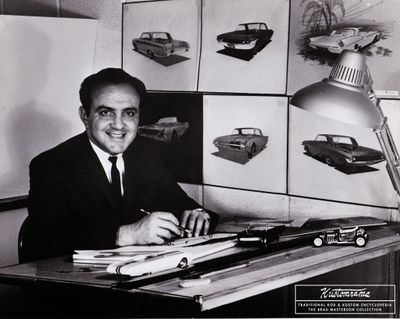
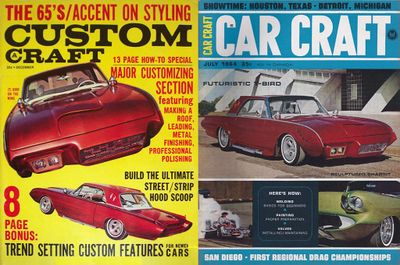

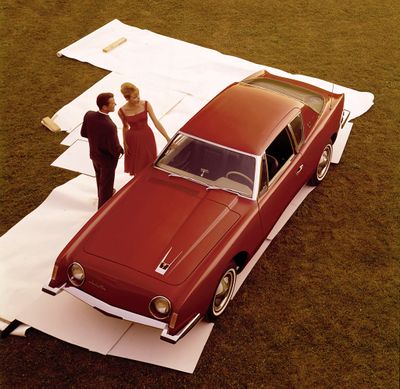



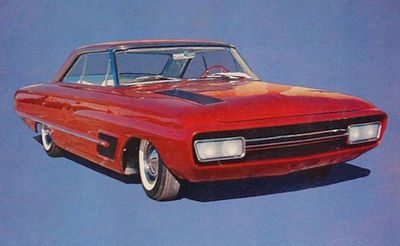
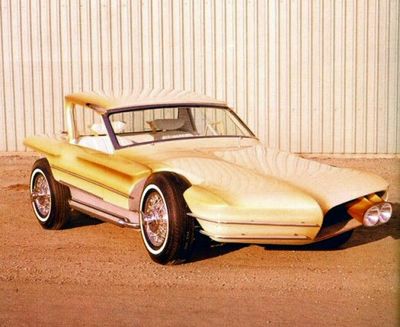
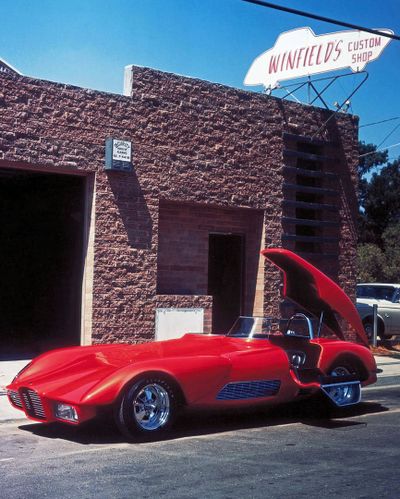

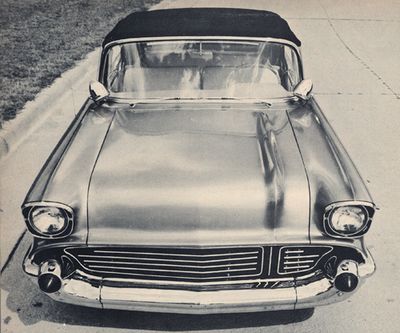










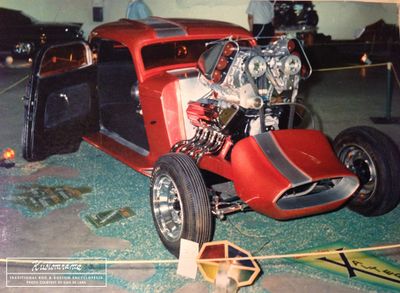





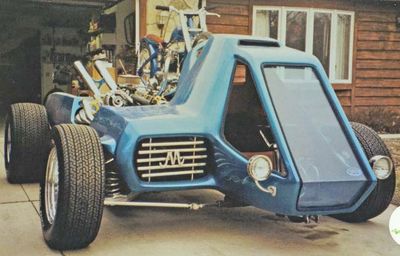






Asymmetrical styling had its peak in the mid-1960s. It is advanced, and it is a daring and distinguished custom technic. Asymmetrical styling gives the car a non-balanced appearance, and it requires imaginative and unconventional thinking to succeed. In 1962 George Barris predicted that asymmetrical styling would be the big design news in 1962!
Contents
- 1 Virgil Exner - A pioneer in the field
- 2 Virgil Exner and the XNR
- 3 Robert Eidschin and the importance of the driver
- 4 George Barris predicts that asymmetrical styling will be the big design news in 1962
- 5 The Alexander Brothers and the Adonis
- 6 Barris and Cushenbery
- 7 Tex Smith's XR-6
- 8 The Ford Custom Car Caravan
- 9 The Car Craft Dream Rod
- 10 Gene Winfield and the Strip Star - The show car tha actually ran!
- 11 Ray Farhner and the Outer Limits
- 12 Dave Puhl's 1957 Chevrolet
- 13 Ed Roth and the Mysterion
- 14 Dean Jeffries and the Mantaray
- 15 The Orbitron and the Surfite
- 16 New times and themes ahead
- 17 Dave Puhl and the Illusion
- 18 Darryl Starbird on Asymmetrical Styling
- 19 Howard Gribble on Asymmetrical Styling
- 20 The end of an era
- 21 "Just a small blip in custom car history"
- 22 Asymmetrical Styled Concept Cars
- 23 Asymmetrical Styled Hot Rods
- 24 Asymmetrical Styled Show Cars
- 25 Asymmetrical Styled Customs Cars
- 26 References
Virgil Exner - A pioneer in the field
Virgil Exner is widely known for introducing and launching the “Forward Look” at Chrysler. He was born in Ann Arbor, Michigan, and showed early on a strong interest in art and automobiles. Exner began his automotive career drawing advertisements for Studebaker trucks. He advanced quickly, and in 1934 Harley Earl hand-picked him to join his design team at General Motors. Before age 30, Exner had been put in charge of Pontiac styling. In 1938 he parted ways with General Motors and went to work for Raymond Loewy’s industrial design firm, where he was put to work on the Studebaker, helping advance their revolutionary post-war cars. Exner went on to work directly for Studebaker as their Chief of Styling before he in 1949 left the position to work for Chrysler in their Advanced Styling Group. Exner worked his way up in the system and was in 1957 elected the first Vice President of Styling at Chrysler. He is best known for his clean “Forward Look” and spectacular fins, but Exner is also a pioneer when it comes to asymmetrical automotive design.[1]
Virgil Exner and the XNR
"Never before has the American public seen off-center styling such as that characterizing the Plymouth XNR." This was how the Plymouth-De Soto-Valiant Division introduced their Plymouth badged Corvette-competitor to the public on March 1, 1960. Exner's proposed Corvette-killer, influenced by old race cars, such as the Jaguar D-Type, featured an unusual asymmetrical design. A large off-set hood scoop, concentrated on the driver's side of the car, led to an extended blister fairing that ran down the hood and into the cowl. The fairing was picked up in the headrest, where it flared back into a stabilizer fin that culminated in a bold chrome asymmetric cross. The cross was a striking design made from the intersection of bumper blade and fin. Originally known as the Plymouth Asymmetrica, the car changed name to XNR, after its designer, during the construction phase.[2] Once revealed, the critics thought that the asymmetrical design it employed was purely a gimmick that could have no practical application. Exner disagreed, and according to Chrysler's promo brochure, the XNR introduced Asymmetrical Design; "an entirely fresh element in automotive aerodynamics which may well affect the shape of cars to come."
Robert Eidschin and the importance of the driver
Looking back, asymmetrical styling seems like a fresh idea for a production car in 1960. At least when it comes to exterior design. Interiors, especially dashboards, had been featuring an asymmetrical design for quite some time. According to Robert Eidschun, who did a story on the XNR and the Asymmetrical Look for the August 1960 issue of CARS Magazine, asymmetrical, or off-center, styling did one thing primarily, “and that was to emphasize the driver’s side of the automobile.” As Eidschun pointed out in the story, a normal car has four wheels. Four contact points. And most cars are designed exactly the same on both areas to the right and the left of the lengthwise centerline to give the feeling that the car is well balanced by weight and steady on the road at all speeds. Eidschun felt that the driver was overlooked in a symmetrically designed car. Lost in the mass of sheet metal surrounding him. “Should this be?” Robert asked the readers? He did not think so, and one way to eliminate this situation was to turn to the asymmetrical styling theme; “The driver, being the most important part of an automobile, logically demands predominance of position and function. That is why the instruments, for example, are placed directly in front of him whenever possible.” Eidschun thought the car should be designed outward from the driver, making him the center of importance. You would then end up with a design that gave the driver the best position in which to control his vehicle. Eidschun’s article contained five concept drawings that ranged from “conservative” to wild. These were used to see how the principle could be applied to present-day cars, and Eidschun admitted that they might as well be adapted by customizers who were thriving for a futuristic look.[3]
George Barris predicts that asymmetrical styling will be the big design news in 1962
Maybe the driver was getting a little overlooked in the late 1950s? Back then, many cars and owners became one, and teenagers started talking about cars such as the Matranga Merc and the Hirohata Merc. It was the car that truly mattered, and as John DeWitt points out in his book “Cool Cars, High Art: The Rise of Kustom Kulture”, “even the evolution of preferred driving positions reinforced a shift of attention from the driver to the car. In the beginning of the decade, the cool way to drive was the straight-up position where the driver sat up almost leaning on the steering wheel, keeping his back away from the seat. This position said, "look at me driving this car." At the end of the decade, the preferred slumped-down position where the driver was nearly invisible announced: "look at my car, look at my car." There was a sense of achievement and status in having a great car, and outdoing the other guy in the schoolyard parking lot became more important than ever for teens all over the US.[4] The same goes for ambitious builders that were struggling to build or maintain a name, a reputation, a business, a career, and an income around their passion for restyled cars. Outdoing the other guys at the shows had become more important than ever. George Barris was an innovator and a trendsetter in the field. Barris was visiting shows all over the country, talking to people, observing, and constantly soaking up inspiration and new ideas. When Bob Behme of Car Craft Magazine asked George about his predictions for 1962, George told Bob that 1962 customs, whether made from new or old cars, would tend to be asymmetrical, built with styling embodying off-set design. “Asymmetrical styling has been exhibited in the past, but such designs have been rare,” George told Behme. “Asymmetrical styling will be the big design news in 1962. You will see floating headlights and off-set scoops coupled with the concept of off-balance, radical styling.”
The Alexander Brothers and the Adonis
Thanks to the Alexander Brothers, Detroit was never far behind when it came to executing the latest custom trends. In fact, it seems like Mike and Larry Alexander even beat George Barris to the finish line when it comes to modifications such as asymmetrical styling. Mid-September 1961, the Alexander Brothers completed the second iteration of Bill Whetstone's 1960 Ford Starliner. By then, an already famous Alexander Brothers custom known as the Adonis. The first iteration of the Adonis was completed about a week before the 1961 Detroit Autorama. It won "Best Custom" at the show and went on to become a featured car on several shows in the area for the rest of the 1961 season. While touring the car, Bill became friends with Bud "the Kat" Anderson of AMT model car company, and together they started to plan a new and reworked version of the car. In 2019 Bill told Kustomrama that the asymmetrical scoop was Bud's idea; "We came up with all the changes for the second version of the car on a model of a 1960 Starliner we were reworking in Bud's basement. Once the model was finished, I took it to Mike and Larry to show what I wanted them to do." Redoing the car was necessary to stay competitive in the show circuit and get paid for being a featured car. Originally painted in a Candy Wild Cherry, the second iteration of the Adonis featured a Candy Blue paint job with radiused wheel wells, shaved fins and an asymmetrical single scoop in the hood. Once completed, Bob Larivee of Promotions Inc. called Bill and asked if he could use the Adonis as a featured car on a show in Houston, Texas. The car was still a crowd-pleaser, and it went on to become a featured car for the whole 1962 season as well, shown next to Bill Cushenbery's radically restyled El Matador 1940 Ford Coupe.[5] The November 1962 issue of Custom Craft magazine contained a "How to" story by Alex Waldory that step by step showed readers how they could cut a hole in their hoods and turn it into a scoop. Titled, "The New Look: Asymmetrical Scoops for Custom Hoods," the story gives credit to Virgil Exner and the XNR; "Since Chrysler's XNR dream car came out with offset fin and headrest, the asymmetrical look has been the rage at custom shows." The story pointed out that people constantly stopped to admire the car every time Bill drove by; "And that offset scoop is a major attraction."[6]
Barris and Cushenbery
On the West Coast, Dick Axcell's Candy Red Pearl 1962 Ford Thunderbird was one of the first asymmetrical customs to appear on the scene. Restyled by George Barris and his talented crew of craftsmen at Barris Kustoms, the build made its debut in 1962. The list of modifications included a unique off-set headlight, an asymmetrical grille, and an asymmetrical hood scoop. Mild alterations that still resulted in a dramatic and futuristic front end. In Monterey, farther up north, Bill Cushenbery gave Barris a run for his money, experimenting with asymmetrical design around the same time. After completing the El Matador, Cushenbery was by 1962 rated by many as the best new customizer in America. Gene Boucher's 1956 Ford was Cushenbery's awaited second coming after the El Matador. Named Marquis, it was shown at the 1962 National Roadster Show in February of 1962, featuring an off-center hood fin. A rather subtle modification on this radically restyled custom, that long list of features included a canted headlight and bumper formation and a sectioned body, but it was a hint about what the future held.
Tex Smith's XR-6
Still, in an early phase, asymmetrical styling was established as an emerging trend in 1962. A year later, Tex Smith's experimental XR-6 roadster was named America's Most Beautiful Roadster at the 16th annual National Roadster Show. Steve Swaja submitted the design of the body, and the car was developed to investigate the uses of modern ideas in hot rod design. A series of articles announced the build in the spring of 1962. A steel 1927 Ford Model T body was delivered to George Barris where the bodywork began. Barris made the body shell and rear pans out of sheet metal, while Gene Winfield was hired to construct the fenders and the nose piece out of aluminum. Swaja's design featured an off-center scoop that ran from the nose piece, over the hood, and into the dash. The rear of the car featured an asymmetrical scoop behind the driver seat, and an asymmetrical nerf bar and license plate arrangement. A theme well aligned with Eidschun's philosophy.
The Ford Custom Car Caravan
Back in Detroit, Ford Motor Company was struggling to get into the youth market. A struggle that led them to work with Bud Anderson of AMT. Ford saw an opportunity when it came to showcasing their cars to custom car fans through nationwide shows and magazines, and in the fall of 1962 they teamed up with the popular model car kit company to launch the "Custom Car Caravan." Under the leadership of Ford Special Projects Division, the "Custom Car Caravan" was launched to create and campaign customized and performance-themed Fords. Or, as Ed Roth described it in his book, "making sure all of Ford's stuff was in the car shows around the country." The first cars were built in-house, but it didn't take long before Ford started to commission famous customizers such as George Barris, the Alexander Brothers, Bill Cushenbery, and Gene Winfield to dream up and execute life-size Ford customs. The builders would propose a drawing, and if Ford liked it, they'd give out a car for a dollar. According to Gene Winfield, AMT organized and administered the Caravan, while Ford paid for it. AMT's part of the deal was that they would get the rights to promote and sell the cars in kit form.
The first car Gene Winfield built for the Custom Car Caravan was a 1963 Ford Econoline pickup called "The Pacifica." Painted a beautiful blue color, the Pacifica featured an off-set grille up front that was fitted with chromed horizontal bars and the emblem FORD above. It had a single headlight on the right-side, and twin headlights on the left. The front and rear bumpers were of a floating design, split, with one half longer than the other. The license plate was placed between the bumpers. Dodge taillights dressed up the rear of the car. One on each side, but with one backup light placed inboard on the right side and a FORD emblem on the left side. Chromed horizontal bars and rectangular headlights could also be found on the Franciscan, a 1963 Ford Falcon convertible that Winfield also restyled for the "Custom Car Caravan." Painted Green Kandy over a pearl base, the Franciscan was also given an asymmetrical treatment, but it was limited to an off-set nameplate on the rear of the car. Other asymmetrical builds of the Ford Custom Car Caravan included the 1963 Ford Falcon, the 1963 Ford Coyote, and the 1964 Ford Alexa. The Alexa was restyled by Mike and Larry Alexander, and just as the Adonis, it featured an asymmetrical air intake on the passenger side of the hood.
The Car Craft Dream Rod
Indoor custom car shows were attracting crowds of paid spectators in the early 1960s, and as a result of this, Bob Larivee of Promotions Inc. had no shortage of funds when it came to promoting the shows he was producing. Promotions Inc. was in charge of various indoor car shows, such as the Detroit Autorama, and every year, Larivee commissioned new cars by some of the top custom builders for his shows. Early in 1963, he commissioned Bill Cushenbery to build him a car. Larivee had already purchased the El Matador from Cushenbery, and now he wanted him to build him a car from scratch. Cushenbery, who started the year by taking home the "Tournament of Fame" title at the prestigious National Roadster Show with his Silhouette bubble top build, was approached by Larivee after he had seen the Silhouette at the show. Bob wanted Cushenbery to bring the design he had for the Car Craft Dream Rod alive. The Dream Rod was a show car designed by the staff of Car Craft Magazine, and it featured a body made from late-model body panels. The front end consisted mostly of 1960 Pontiac parts, while the rear end was made from 1960 Chevrolet Corvair parts. Early in 1963, Larivee revealed in the souvenir program for the 11th annual Detroit Autorama that he had commissioned Cushenbery to build the car and that the main purpose of building the car was to show it through the circuit of shows he had scheduled for the 1963-64 season. Presented as a practical and beautiful build, the story contained the original drawings from the October 1961 issue of Car Craft Magazine. This version did not feature asymmetrical styling. Cushenbery completed the build in time for the 1963-64 season. By then, the Dream Rod had received an off-set hood and nose peak that ran down the passenger side of the car, separating one oversized grille opening on the driver side, and slim nerf-bar style bumpers on the passenger side. Dual floating headlights peeked out of the off-set grille opening up front. The reworked rear of the car carried an asymmetrical design as well, and the driverside featured taillights, while the passenger side carried a license plate.
Gene Winfield and the Strip Star - The show car tha actually ran!
While working for the Custom Car Caravan, Gene Winfield had the opportunity to travel to most of the national custom car shows and meet people in the industry. On one of those tours, Gene approached Bob Larivee about building him a car as well. Larivee accepted Gene's offer, and after receiving the green light on an asymmetrical show and competition car that Ernie Graves had designed, construction of the Strip Star could begin. A 1948 Ford chassis was dressed up with an asymmetrical offset hand-formed aluminum body. The front end of the car ran an off-center asymmetrical grille and headlight assembly, while a canopy roof over the driver laid the foundation for the asymmetrical rear end design on the car. Completed in 1964, the Strip Star was featured in the January 1965 issue of Hot Rod Magazine. An early iteration of the build had been tested on Bonneville in 1963, and it went on tour across the country promoted as the show car that actually ran!
Ray Farhner and the Outer Limits
In 1963 Popular Customs announced that asymmetrical styling had become the hottest styling trend in the world. In Kansas City, Missouri, Ray Farhner set out to give a brand new 1963 Chevrolet Corvette Sting Ray split-window coupe an asymmetrical makeover. With less than 100 miles on it, the car had fell victim to a high-speed crash. Tom Davison was there when the car was delivered, and he remembers that Ray spent six weeks rebuilding and restyling the Corvette into the "Outer Limits." Outer Limits was Ray's first sports car restyling project. Tom was only 19 years old at the time, and he contributed ideas to the styling of the car when Ray was building it. Ray even let Tom give the car a custom fade paint job. Once completed, Ray's Corvette featured an asymmetrical theme that ran off-set twin grilles up front. The left one featured two Deitz headlights, while the right one received a hand-formed louvered chrome grille. The rear of the car featured one taillight on the right side and a recessed license plate on the left side.[7]
Dave Puhl's 1957 Chevrolet
In Wichita, Kansas, Dave Puhl was also experimenting with asymmetrical design. Puhl was working as a shop foreman for Darryl Starbird when his personal driver, a mildly restyled 1957 Chevrolet custom, landed the cover of the Winter 1963 issue of Popular Custom. Puhl’s Chevrolet had been stripped for unnecessary chrome before Dave had given it a subtle asymmetrical makeover. One of the hood peaks on the car was removed. The remaining one was extended the full length of the hood before Puhl made an off-center grille to match. Simple and classy.
Ed Roth and the Mysterion
Ed Roth's famous bubble top builds deserves credit when it comes to the popularity of the asymmetrical trend in the 1960s. Ed had been running around the shows with Bud "The Cat" Anderson back then, and as Bud was in charge of Ford's Custom Car Caravan, he gave Roth three brand new Ford mills with trannys for his next build. The Mysterion was Roth's first attempt at the emerging trend, and he got the initial inspiration for the build from the dragstrips, where cars with two, three, or even four engines started popping up. Painted a striking Candy Yellow by Larry Watson, the Mysterion featured two fully chromed engines, a bubble top, an oblong grille, and an odd-shaped nosepiece, with one large, pod mounted headlight on the left, and a smaller conventional light on the right. The rear of the car did also feature an asymmetrical peak that was carried over the deck and up on the back of the bubble top. The build was completed in 1963 and put on tours all across the country.
Dean Jeffries and the Mantaray
Dean Jeffries was another up and coming Southern California customizer that helped put the asymmetrical design on the map in the 1960s. After practicing the trade at Barris Kustoms, Jeffries wanted to prove that he was capable of competing head to head with his old boss. Custom-built cars were the latest rage at the time, so Jeffries decided to go all in with a bubble-topped show rod called the Mantaray. The entire chassis on the Mantaray came from a pre-war Grand Prix Maserati. Incorporating asymmetrical design, the body was hand-formed in aluminum by Jeffries and helper Jim Burrell. The Mantaray became an overnight success that put Jeffries in the winner’s circle at the 1964 Grand National Roadster Show in Oakland, where he won the prestigious Tournament of Fame award. It also landed the cover of Hot Rod Magazine and made Dean Jeffries a household name in garages all across the US.
The Orbitron and the Surfite
After touring the Mysterion for some time, Ed Roth ended up renting it out to Bob Larivee. Roth returned to his Southern California shop, where he built the Orbitron, his second asymmetrical themed creation. The Orbitron was revealed in 1964, and the most striking feature on the car was an off-set nose that housed a red, green, and blue-tinted headlight. Roth's idea was that when the three lights hit the road, they would turn into a white beam. It became a failure at the shows, so Roth sold it off to a fellow in Texas before returning to California to build the cartoonish Surfite, another asymmetrical show car penned by his buddy Ed Newton. Completed in 1964, the Surfite did not have a bubble top, but it flirted with the popular surf trend and came with an off-set surfboard holder.
New times and themes ahead
In 1965 a new breed of builders started taking over the scene, and suddenly it seems like everyone had forgotten asymmetrical styling. Steve Scott's groundbreaking Uncertain-T show rod made its debut early in the year at the 1965 Winternationals, where it stole the Special Sweepstakes Award from under George Barris' nose. George did not like this, and he ended up slapping the 22-year-old kid in the face at the end of the show. Later on, the same year, Dan Woods' debuted his Milk Truck show rod at the Tridents Rod Custom Autorama. Just as Steve, Dan had built the Milk Truck in his parent's garage. He was 17 years old when the build started, and 18 years old when he debuted it. It won the Sweepstakes that weekend and landed the August 1965 cover of Rod & Custom magazine. Woods signed a contract with car show promoter Gary Canning, and the truck was put on tour up and down the West Coast. According to hot rod and custom car historian Pat Ganahl, the Milk Truck had a theme, a name, and a cartoon quality that attracted and intrigued show goers, especially kids, and it helped launch a string of such themed cartoon cars.
Dave Puhl and the Illusion
Dave Puhl's Illusion was one of the last big asymmetrical builds to hit the circuit. It was featured in the December 1965 issue of Hot Rod Magazine, and according to Eric Rickman, the Ford-based custom coupe exploited a full expression of the modern trend toward asymmetrical design. Constructed from ⅝ inch tubing and hammer welded sheets of metal. A brushed aluminum divider ran from the front to the rear on the driver side of the car, highlighting the asymmetric design, and the different sides of the car.
Darryl Starbird on Asymmetrical Styling
Dave Puhl was working for Darryl Starbird when his 1957 Chevrolet was featured on the cover of Popular Customs. Darryl was not a fan of asymmetrical styling, and in 2019 he told Sondre Kvipt that he tries hard to improve on the design of a car when he customizes it; "If I feel the car design is totally beyond what I can do to improve on to bad or to good I won't touch it. I feel asymmetrical design is not an improvement but a change for the shock of change not improvement. A lot of customizers over the years have made changes to get attention and to shock their customers and the public, that was never in my plans."[8]
Howard Gribble on Asymmetrical Styling
When it comes to automotive design, the asymmetrical look ranges from subtle details to dedicated builds such as Dave Puhl's Illusion. Born in Michigan, it is a distinguished trend that never really became mainstream. It wowed show-goers, but it never really made it out on the streets. I asked custom car historian Howard Gribble about this, and he told me that he believes that the public wasn't ready to embrace a style that went seemingly against the grain of what was the commonly thought of being good design; "Certainly I think George Barris overstated the case for asymmetric styling in his predictions. I think I've made this point before. Customizing was a young man's game then, but even so, most of the kids were inclined to follow the trends they saw in the high school parking lots and drive-ins rather than picking up on Barris' ideas of what the new year had in store. For most people, asymmetrical styling just didn't "look right"."
The end of an era
By 1966 the big names of customizing were pushing new trends and concepts, continually trying to impress and astound show-goers. A crowd that kept getting younger and younger. According to John DeWitt, the trading card companies began offering custom car and hot rods cards in the 1960s to attract an even younger audience; "By the sixties the model business had grown so big that car builders were being driven by the need to come up with wackier and wackier cars to satisfy the companies who were trying to please their customers - twelve-year-old boys!" Custom cars started becoming scarce. Lowriders were taking over that scene, at least in Southern California, and many of the big names in customizing went on to take on jobs from the car manufacturers. But what about Virgil Exner? The XNR became one of his last show cars for Chrysler. Exner refused to downsize the 1962 Chryslers he was designing and was eventually laid off by Chrysler. Robert Eidcshun, he went on to design the popular Pinto, Ford's little carefree car.
"Just a small blip in custom car history"
Today, the asymmetrical look seems to be just as scarce as it was in 1961, and I want to end this story with a quote from hot rod and custom car collector, builder and restorer Mark Moriarity of Mound, Minnesota. Mark has owned and restored several asymmetrical customs, and he is a keeper of the flame when it comes to 1960s hot rods and customs; "Even though asymmetric styling was just a small blip in custom car history, it left us with some of the most amazing and striking custom cars in history. It must have been really something to have been able to live it in a time when the sky was the limit as far as design. My hat is off to all the custom builders of the era." Think about the next time you go out into the garage to work on your next big project!
Asymmetrical Styled Concept Cars
Asymmetrical Styled Hot Rods
Andy Kassa's 1932 Ford 3-Window Coupe - The Cyclops Deuce
Joe Briske's 1934 Ford 3-Window Coupe - The X-Altered
Tex Smith's XR-6
Asymmetrical Styled Show Cars
Dave Puhl's Illusion
Dean Jeffries' Mantaray
Ed Roth's Mega Cycle - Captain Pepi's Motorcycle & Zeppelin Repair
Ed Roth's Mysterion
Ed Roth's Orbitron
Ed Roth's Surfite
Eric Goodrich's Iron Lung
The Car Craft Dream Rod
The Forcasta
The Strip Star
Asymmetrical Styled Customs Cars
Rodney Rice's 1955 Chevrolet - The Astorian
Jan Serrander's 1955 Ford Sunliner - The Green Trash
Dan Tschan's 1956 Chevrolet - The Golden Chariot
Gene Boucher's 1956 Ford - Marquis
Björn Ramsten's 1957 Chevrolet
Dave Puhl's 1957 Chevrolet Convertible
Andy Kassa's 1957 Ford Thunderbird
Ron Volpe's 1957 Ford Convertible - Red Robin II
Bill Whetstone's 1960 Ford Starliner - The Adonis
Dick Axcell's 1962 Ford Thunderbird
Ray Farhner's 1963 Chevrolet Corvette - Outer Limits
1963 Ford Econoline Pacifica
1963 Ford Falcon Franciscan
1964 Ford Galaxie Alexa
Gene Winfield's Pacifica Recreation
References
Did you enjoy this article?
Kustomrama is an encyclopedia dedicated to preserve, share and protect traditional hot rod and custom car history from all over the world.
- Help us keep history alive. For as little as 2.99 USD a month you can become a monthly supporter. Click here to learn more.
- Subscribe to our free newsletter and receive regular updates and stories from Kustomrama.
- Do you know someone who would enjoy this article? Click here to forward it.
Can you help us make this article better?
Please get in touch with us at mail@kustomrama.com if you have additional information or photos to share about Asymmetrical Styling.
This article was made possible by:
SunTec Auto Glass - Auto Glass Services on Vintage and Classic Cars
Finding a replacement windshield, back or side glass can be a difficult task when restoring your vintage or custom classic car. It doesn't have to be though now with auto glass specialist companies like www.suntecautoglass.com. They can source OEM or OEM-equivalent glass for older makes/models; which will ensure a proper fit every time. Check them out for more details!
Do you want to see your company here? Click here for more info about how you can advertise your business on Kustomrama.







